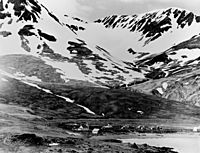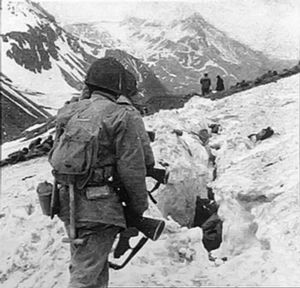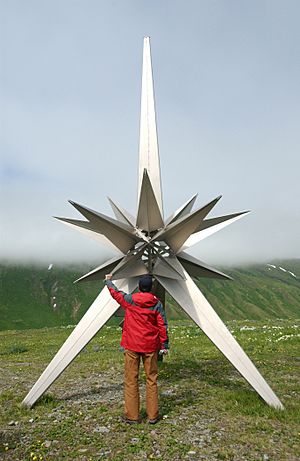Attu Island facts for kids
|
Native name:
Atan
|
|
|---|---|
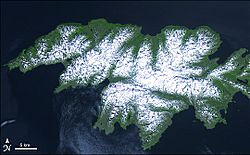
Attu Island
|
|
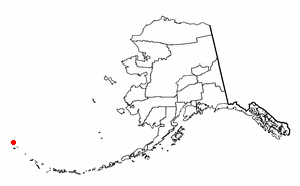 |
|
| Geography | |
| Coordinates | 52°54′09″N 172°54′34″E / 52.90250°N 172.90944°E |
| Archipelago | Near Islands group of the Aleutian Islands |
| Area | 344.7 sq mi (893 km2) |
| Length | 35 mi (56 km) |
| Width | 20 mi (30 km) |
| Highest elevation | 2,946 ft (897.9 m) |
| Highest point | Attu Mountain |
| Administration | |
|
United States
|
|
| State | Alaska |
| Census Area | Aleutians West Census Area |
| Demographics | |
| Population | 20 (2010–present) |
Attu (Aleut: Atan, Russian: Атту) is an island in the Near Islands (part of the Aleutian Islands chain). It is the westernmost point of the U.S. state of Alaska. The island became uninhabited in 2010, making it the largest uninhabited island to be politically part of the United States.
The Battle of Attu was the site of the only World War II land battle fought in the United States. The battlefield area is a U.S. National Historic Landmark.
Attu Station, a former Coast Guard LORAN station, is located at 52°51′N 173°11′E / 52.850°N 173.183°E, making it one of the westernmost points of the United States relative to the rest of the country. However, since it is in the Eastern Hemisphere, being on the opposite side of the 180° longitude line of the contiguous 48 states, it can also be considered one of the easternmost points of the country (a second Aleutian Island, Semisopochnoi Island at 179°46′E, is the easternmost location in the United States by this definition). For purposes of the calendar date, the International Date Line, however, passes to the west of Attu Island, making it the westernmost place in the United States with the same date.
In the chain of the Aleuts, the next island to the west of Attu are the Russian Commander Islands, 208 miles (181 nmi; 335 km) away (and on the other side of the International Date Line). Attu is nearly 1,100 miles (960 nmi; 1,800 km) from the Alaskan mainland and 750 miles (650 nmi; 1,210 km) northeast of the northernmost of the Kuril Islands of Russia, as well as being 1,500 miles (1,300 nmi; 2,400 km) from Anchorage, 2,000 miles (1,700 nmi; 3,200 km) from Alaska's capital of Juneau, and 4,845 miles (4,210 nmi; 7,797 km) from New York City. Attu is about 20 by 35 miles (32 by 56 km) in size with a land area of 344.7 square miles (893 km2), making it #23 on the list of largest islands in the United States. The population in the 2010 census was 20 people, all at the Attu Station, though all inhabitants left the island later in the year when the station closed. It then became the largest uninhabited island in the United States.
In 1982, the only significant trees on the island were those planted by American soldiers at a chapel constructed after the 1943 battle when the Japanese occupation was over; they have since gone.
Although Attu Island is the westernmost body of land east of the International Date Line, its time zone is the same as other western Aleutian Islands, UTC−10, which means that locations to the south-southeast (such as the uninhabited Baker Island and Howland Island in UTC−12 and Niue, Midway Atoll and American Samoa in UTC −11) have earlier clocks.
Contents
History
The name Attu is a transliteration of the Aleut name of the island. It was called Saint Theodore by the explorer Aleksei Chirikov in 1742. Attu, being the nearest to Kamchatka, was the first of the Aleutian Islands exploited by Russian traders. The first population estimate by the Russians put at most 175 Aleuts on Attu. However, the large number and size of archeological sites on Attu have led to estimates of 2,000–5,000 inhabitants during the centuries preceding European contact. Russians would stay multiple years on the island hunting sea otters, often clashing with the local Aleut population. After the initial wave of traders, Attu was largely overlooked by ships heading further east.
World War II
|
Attu Battlefield and U.S. Army and Navy Airfields on Attu
|
|
| Lua error in Module:Location_map at line 420: attempt to index field 'wikibase' (a nil value). | |
| Built | 1942 |
|---|---|
| NRHP reference No. | 85002729 |
| Significant dates | |
| Added to NRHP | February 4, 1985 |
| Designated NHL | February 4, 1985 |
The Aleuts were the primary inhabitants of the island prior to World War II. But, on June 7, 1942, six months after the USA joined the war, the 301st Independent Infantry Battalion of the Japanese Northern Army landed on the island, without opposition, one day after landing on nearby Kiska. Earlier, in response to Japanese aggression in the Pacific, American territorial authorities conducted a mandatory evacuation of about 880 Aleuts from villages elsewhere in the Aleutian Islands. These people were interned in civilian camps in the Alaska Panhandle, where about 75 of them died of various infectious diseases over two years.
However, Attu Village had not yet been evacuated when the Japanese attacked. At the time, Attu’s population consisted of 45 native Aleuts and two other Americans, Charles Foster Jones, 60, a radio technician, originally from St. Paris, Ohio and his wife Etta, a schoolteacher, originally from Vineland, New Jersey. The village consisted of several houses around Chichagof Harbor. The 42 Attu inhabitants who survived the Japanese invasion were taken to a prison camp near Otaru, Hokkaidō. Sixteen of them died while they were imprisoned.
Before the Attu villagers were returned to the U.S., the American government stated publicly that it was not aware of their status.
According to Gen. Kiichiro Higuchi, the Commander of the Japanese Northern Army, the invasion of Kiska and Attu was part of a threefold objective:
- To break up any offensives against Japan by way of the Aleutians.
- To place a barrier between the U.S. and Russia in case Russia decided to join the war against Japan.
- To make preparation for air bases for future offensive action.
In late September 1942, the Japanese garrison on Attu was transferred to Kiska, and then Attu was essentially left unoccupied, but American forces made no attempt to occupy Attu during this time. On October 29, 1942, the Japanese reestablished a base on Attu at Holtz Bay under the command of Lt. Col. Hiroshi Yanekawa. Initially the garrison was about 500 troops, but through reinforcements, that number reached about 2,300 by March 10, 1943. No more reinforcements arrived after that time, owing mainly to the efforts of the U.S. naval force under Rear Admiral Charles "Soc" McMorris, and U.S. Navy submarines. McMorris had been assigned to interdict the Japanese supply and reinforcement convoys. After the sizable naval Battle of the Komandorski Islands, the Japanese abandoned their attempts to resupply its Aleutian garrisons by surface ships. From then on, only submarines were used for the resupply runs.
On May 11, 1943, the American operation to recapture Attu began. A shortage of landing craft, unsuitable beaches, and equipment that failed to operate in the appalling weather caused great difficulties in projecting any force against the Japanese. Many soldiers suffered from frostbite – because essential supplies could not be landed, or having been landed, could not be moved to where they were needed. Army vehicles would not work on the tundra. The Japanese defenders under Colonel Yasuyo Yamasaki did not contest the landings, but rather they dug in on high ground away from the shore. This resulted in bloody fighting: there were 3,929 U.S. casualties: 580 were killed, 1,148 were injured, 1,200 had severe cold injuries, 614 succumbed to infectious diseases, and 318 died of miscellaneous causes – largely from Japanese booby traps and from friendly fire. The Japanese were defeated in Massacre Valley. The death count for the Japanese was 2,035. The Americans then built "Navy Town" near Massacre Bay.
On May 29, the last of the Japanese forces suddenly attacked near Massacre Bay in one of the largest banzai charges of the Pacific campaign. The charge, led by Colonel Yamasaki, penetrated U.S. lines far enough to encounter shocked rear-echelon units of the American force. After furious, brutal, close-quarter, and often hand-to-hand combat, the Japanese force was eliminated almost to the last man: only 28 prisoners were taken, none of them officers. U.S. burial teams counted 2,351 Japanese dead, but it was presumed that hundreds more had been buried by naval, air, and artillery bombardments over the course of the battle.
The other Japanese forces in the Aleutians, after realizing that their position was now vulnerable, evacuated Kiska three months later.
The USAAF built a larger airfield, the Alexai Point Army Airfield, and then used it on July 10, 1943 as the base for an air attack on the Japanese-held Kurile Islands, now a part of Russia. This was the first air attack on the Japanese "homelands" since the famous Doolittle Raid in 1942. Other attacks followed.
Postwar
After the war, the survivors of the Otaru prison camp were shipped to other Aleutian islands or to the mainland of Alaska, as there were not enough survivors to sustain their old village at Attu. The United States government decided to construct a LORAN station on the southern tip of Attu, at Theodore Point. This installation was manned by a crew of about twenty members of the United States Coast Guard. The equipment to build the station came out of Holtz Bay and was ferried on barges and landing craft to Baxter Cove, about one mile east of the station. Bulldozers were used to cut a road from Baxter Cove to Theodore Point.
In 1954, the station was moved to Casco Cove, near the former Navy Base at Massacre Bay. In 1960, it was moved to Massacre Bay.
The battlefield area and subsequent military sites were declared a National Historic Landmark in 1985.
In 1987, with the approval of the U.S. Department of the Interior, the government of Japan placed a monument on Engineer Hill, site of the hand-to-hand finale of the battle against the Japanese. An inscription, in Japanese and English, reads: "In memory of all those who sacrificed their lives in the islands and seas of the North Pacific during World War II and in dedication to world peace."
In July 2007, the boots and foot bones of a Japanese soldier were found on the island, and on May 23, 2008, the remains of two more Japanese soldiers were discovered by U.S. Coast Guard Petty Officer 3rd Class Richard Brahm, a public affairs specialist who was a documentarian for the remains recovery team. More remains were located at the burial site, but were left untouched with plans to return at a later time and have them exhumed properly.
In February 2008, a group of American veterans led by John E. Jonas TSgt USAF (Ret.) began a petition to have the Japanese memorial removed or relocated from the island and replaced with two U.S. funded markers: one to the Japanese soldiers who died on the island and one to the Americans.
Veteran Bill Jones, along with fellow Attu survivor Andy Petrus, were featured in the 2006 documentary film Red White Black & Blue. It is directed by Tom Putnam, and debuted at the 2006 Locarno International Film Festival in Locarno, Switzerland on August 4, 2006.
On August 1, 2010, the United States Coast Guard LORAN station on Attu permanently ceased operation. On August 27, 2010, the station was decommissioned and the Coast Guard personnel left, leaving the island with no resident population.
On June 7, 2012, the 70th anniversary of the Japanese invasion, Senator Lisa Murkowski and United States Coast Guard Rear Admiral Thomas Ostebo dedicated a memorial to Attu Village, its residents who died in Japanese captivity, and the survivors who were unable to return.
Climate
The weather on Attu is typical Aleutian weather: cloudy, rainy, and foggy. High winds occur occasionally. Five or six days a week are likely to be rainy, and there are only about eight or ten clear days a year. The rest of the time, even if rain is not falling, fog of varying density is the rule rather than the exception. There are 39–49 inches (990–1,240 mm) of annual rainfall and other precipitation, with the heaviest rains in the autumn and early winter. According to the Köppen climate classification system, Attu has a subpolar oceanic climate (Cfc) with effects similar to tundra climates. For its latitude the climate is exceptionally chilly, with temperatures averaging mid-50's in summer.
| Climate data for Attu | |||||||||||||
|---|---|---|---|---|---|---|---|---|---|---|---|---|---|
| Month | Jan | Feb | Mar | Apr | May | Jun | Jul | Aug | Sep | Oct | Nov | Dec | Year |
| Record high °F (°C) | 49 (9) |
51 (11) |
49 (9) |
50 (10) |
59 (15) |
64 (18) |
72 (22) |
70 (21) |
68 (20) |
61 (16) |
54 (12) |
49 (9) |
72 (22) |
| Mean daily maximum °F (°C) | 34.4 (1.3) |
34 (1) |
35.3 (1.8) |
38.5 (3.6) |
42.7 (5.9) |
48.4 (9.1) |
52.6 (11.4) |
55.1 (12.8) |
52.2 (11.2) |
46.8 (8.2) |
40 (4) |
35.7 (2.1) |
43 (6) |
| Daily mean °F (°C) | 30.4 (−0.9) |
30.2 (−1.0) |
31.5 (−0.3) |
34.8 (1.6) |
38.9 (3.8) |
43.9 (6.6) |
48.4 (9.1) |
50.5 (10.3) |
47.8 (8.8) |
42.1 (5.6) |
35.5 (1.9) |
31.9 (−0.1) |
38.8 (3.8) |
| Mean daily minimum °F (°C) | 26.3 (−3.2) |
26.4 (−3.1) |
27.6 (−2.4) |
31 (−1) |
35.1 (1.7) |
39.4 (4.1) |
44.2 (6.8) |
45.8 (7.7) |
43.3 (6.3) |
37.4 (3.0) |
31 (−1) |
28.1 (−2.2) |
34.6 (1.4) |
| Record low °F (°C) | 5 (−15) |
7 (−14) |
5 (−15) |
10 (−12) |
15 (−9) |
19 (−7) |
24 (−4) |
28 (−2) |
20 (−7) |
21 (−6) |
15 (−9) |
2 (−17) |
2 (−17) |
| Average precipitation inches (mm) | 3.81 (97) |
3.61 (92) |
3.27 (83) |
3.79 (96) |
2.86 (73) |
2.94 (75) |
4.23 (107) |
6.02 (153) |
6.32 (161) |
6.63 (168) |
4.55 (116) |
4.61 (117) |
52.64 (1,337) |
| Average snowfall inches (cm) | 16.2 (41) |
16.9 (43) |
15 (38) |
6.5 (17) |
1.1 (2.8) |
0 (0) |
0 (0) |
0 (0) |
0 (0) |
0.6 (1.5) |
7.1 (18) |
13 (33) |
76.3 (194) |
| Average precipitation days | 19 | 17 | 18 | 16 | 13 | 11 | 13 | 15 | 17 | 19 | 20 | 19 | 197 |
Birding
Attu was an important location in the world of competitive birding, whose goal is to see and/or hear the largest possible number of bird species within a specific geographic area during a specific time period. Because it is so physically remote from other parts of North America, there are a number of bird species likely to be found on Attu that are not seen anywhere else on the continent. John Fitchen called the island, "the Holy Grail of North American birding".
During his record-setting year of 1998, Sandy Komito spent 4 weeks on the island. Since the closure of Attu Station by the U.S. Coast Guard in 2010, access to the island by birders has been greatly restricted. In a 2010 interview on the subject, Al Levantin (one of Komito's competitors during the 1998 season) singled out inaccessibility of Attu as the factor that would make it nearly impossible to break Komito's record. However, Neil Hayward did break the record, by one species, in 2013 without visiting Attu.
In popular culture
- Attu Island is the location for the 2006 PBS documentary film Red White Black & Blue, which features two American war veterans returning to the island 60 years after surviving the 1943 Battle of Attu during World War II between American and Canadian forces and the Japanese Empire.
- Attu is the setting for part of the 2011 movie The Big Year, which stars Steve Martin, Jack Black, and Owen Wilson as avid birdwatchers who take a trip to the island for exclusive birdwatching.
- Attu Island was visited in 2013 by the co-hosts and crew of Chinese web-documentary On The Road, where they searched the island in an attempt to find fuel for their sailboat.
Demographics
| Historical population | |||
|---|---|---|---|
| Census | Pop. | %± | |
| 1880 | 107 | — | |
| 1890 | 101 | −5.6% | |
| 1930 | 29 | — | |
| 1940 | 44 | 51.7% | |
| 1980 | 29 | — | |
| 2000 | 20 | — | |
| 2010 | 21 | 5.0% | |
| 2017 (est.) | 0 | −100.0% | |
| U.S. Decennial Census | |||
Attu first appeared on the 1880 U.S. Census as the unincorporated Aleut village of "Attoo", which at the time consisted of the village on western Chichagof Harbor. It had 107 residents, consisting of 74 Aleuts, 32 "Creoles" (mixed Russian and Native) and 1 White resident. In 1890, it appeared as Attu. It did not return again on the census until 1930. It appeared on the 1940 census, two years before the Japanese invasion of the village and island. It did not return again until 1980, when it consisted of the naval station residents at Massacre Bay, and was made a census-designated place (CDP). It did not return on the 1990 census. The name was changed to Attu Naval Station and redesignated a CDP in 2000. It last appeared on the 2010 census, just before the closure of the station in August that year and the departure of its remaining residents.
Education
In the pre-World War II period, the Bureau of Indian Affairs (BIA) operated the sole school on the island. At the time of Attu's capture, the school had a single teacher who was a White American woman. As of 2017[update], the uninhabited island is physically within the Aleutian Region School District.
See also
 In Spanish: Isla Attu para niños
In Spanish: Isla Attu para niños


